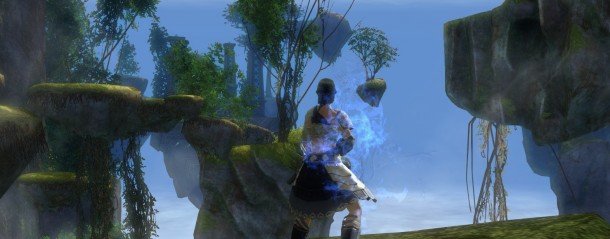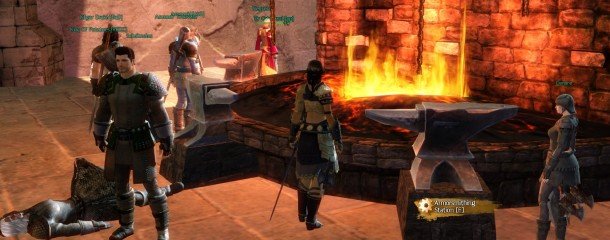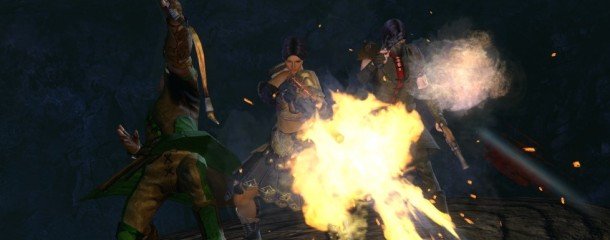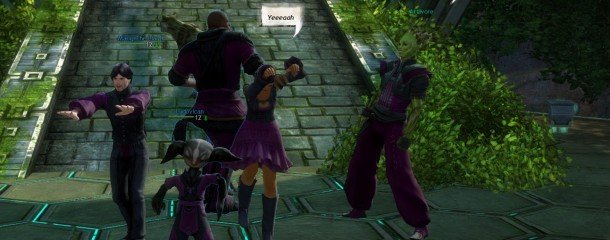Guild Wars 2 review as it happens

Hour 29:
Around level 23, it occurs to me that I've not been back to a crafting table - or Divinity's Reach, for that matter - since my last story quest there, about ten levels ago. The way that Guild Wars 2 does away with the quest hub structure within individual zones seems to apply to the game as a whole. Instead of yo-yoing between the place you want to be and the vendors, quest givers and banks that support your levelling effort, the game is characterised by constant movement outwards. If you're not marching off into the fog of war, you're probably doing it wrong. You're encouraged to follow your nose, and even on the edge of my 30th hour with this character I still find that surprising. I am enjoying being a bumblebee rather than a worker ant. Bees have all the fun.
I've been gathering crafting materials and depositing them in my bank constantly, because it's so easy and painless to do. Gathering grants a chunk of XP equivalent to a few kills, so there's no reason not to pick up everything you see: and the 'deposit all collectibles' button in the inventory automatically files away your raw materials into a dedicated part of your bank. The fact that you get an unlimited capacity to store crafting bits and pieces from the get-go is a classy bit of design. It allows you to use your main bank for fun things - bits of armour you like, weapons you want to transmute later - and belies the fact that selling inventory space is one of the ways that ArenaNet will make money through the gem store. Unshackling available storage space from crafting progression defangs their decision to monetise that part of the game. Classy is the word for it, really: it's a generous bit of thinking, worthy of a hat-tip.
Grabbing all of my crafting materials out of my bank and turning them into (variously) inventory boxes, helmets and soup grants me about half a level's worth of experience, which is a pleasant surprise. I was aware that crafting granted XP but I hadn't seen it as a viable alternate progression route. I now know that it's how the first person to level 80 managed the last twenty levels, and while the average player won't have the support of a whole guild this sense that nothing you do is a waste of time makes you feel free to wander.

Wandering is the thing, really. After burning through all my copper and thread I drag three friends into a party so that I can show them a hidden jumping puzzle in a cave far to the south-east of Queensdale. I was originally taken through it by the developers as part of a press event, and I like the idea of playing tour-guide. We could port to a waypoint closer, but someone asks if we can walk from Divinity's Reach instead, because walking allows adventures to happen. I really hope that sentiment becomes a defining element of GW2's community: rather than SWTOR instance-runners demanding that everyone skip the cutscenes, I want to see players asking to take the scenic route.
As it happens, a major centaur assault takes place as we're taking the bridge near Shaemoor. The event scales up to factor in the participation of four geared-up players, and we find ourselves quickly annihilating twenty or so horsemen alongside a load of new characters. It's a cool feeling: we're leveled down to match the area, but our gear and abilities show off our time investment. Rather than watching high-level players float through beginner areas like invincible gods, new players get to fight alongside them. It's a clever way of keeping the community together.

It's necessary to point out that it's still very difficult to get a party of people together in the same version of a zone, and that difficulty increases the more people you add. I'll take overflow servers over queueing any day, but the fact that parties are discouraged from changing zone due to the necessity of waiting for everyone to get into the right one is a problem. Sometimes, the game seems to figure out that moving a party into the same overflow is the right thing to do: but it's inconsistent, and it needs to stop being so as a matter of priority.
The biggest gaming news, reviews and hardware deals
Keep up to date with the most important stories and the best deals, as picked by the PC Gamer team.
Jumping puzzles are one of Guild Wars 2's quirks. They feel like a designed version of the kind of glitchy cliff-jumping that accompanied determined exploration in World of Warcraft: the drive that spurred players to try and worm their way up a boundary hill just because they could. Guild Wars 2 encourages and rewards that kind of play by sticking a vista or a boss monster or a chest of loot at the end of an improbable series of leaps.
If this was a platformer, its basic jumping mechanics would be far from where they need to be. You have a little mid-air control, but it doesn't feel substantially different to hopping around in any other MMO. Nonetheless, these puzzles add a slapstick side to the game that makes bounding around feel novel. It's fun to watch someone tumble off a rock spire and have to fight every spider in the world while their friends provide covering fire (and insults) from above.
After finishing off the Queensdale jumping cave we head to Metrica, the Asura starting area. There's a jumping puzzle here that takes place on a series of floating islands above the cloud layer. It's accessible by a portal in a well-hidden cave, which is also where players respawn if they take a nasty fall. It's very difficult - there are leaps straight down onto unseen platforms, vines where you have to time your movement against gusts of wind, lightning bolts, and bursts of frozen cloud that halve your jump distance.
While we're waiting for the rest of our group to arrive, a few of us do what MMO players do when they're stuck in one place: we dance. Then, we switch over to our casual clothes - an alternate, cosmetic armour set. Then, we agree on a dye colour and coordinate our outfits. Then, myself and the other human player count down from three over Skype and trigger our /dance commands at the same time. Then our Asura starts to dance in front of us. Then a Norn behind us. A Sylvari stranger wanders up and joins in. I tell him what dye we're using, and he changes his clothes to match. An entirely unplanned and genuinely hilarious dance troupe forms in front of the portal, pieced together bit by bit from mechanics - dye and casual clothes - that I'd not really seen a use for. That use looks something like this:

Click here for the animated version.
Games, everybody. Actually, no, wait: human beings , everybody.
Hour 30:
I'm currently level 26, and I've just entered the third human zone with a near-full set of green top quality equipment. I've made some changes to my build - I'm back to sword and shield after a long stint with dual axes - and as a result combat has had life injected back into it. Not that it had become a drag, per se - more that I'd gotten comfortable, and finding a new weapon shook me out of my complacency. The game is able to do this because it makes shifting skills around so painless. Even the traits system, where decisions are more permanent, supports this: decisions are based around styles of play rather than specific pieces of equipment. Whether I'm going for axe-based damage spikes or stacking damage over time with my sword, my investment in critical hit chance and condition duration is rewarded.
I've written thousands of words so far on instances where I've been surprised by the sense of freedom that Guild Wars 2 encourages, or by the feeling that it respects my time and my right to have fun regardless of the hours I'm capable of pouring into it. The great big unspoken truth here is that these things are notable because other games in its genre do not feature them or give them up reluctantly. That, I think, is why this game is going to be important. I'm still not sure if it's going to convince every jaded ex-MMORPG player that they could love again - though some of my most cynical gamer friends have been overwhelmingly positive about it - but because it encourages people to ask tougher questions about what is and isn't a respectful use of the player's time and money.
Joining in 2011, Chris made his start with PC Gamer turning beautiful trees into magazines, first as a writer and later as deputy editor. Once PCG's reluctant MMO champion , his discovery of Dota 2 in 2012 led him to much darker, stranger places. In 2015, Chris became the editor of PC Gamer Pro, overseeing our online coverage of competitive gaming and esports. He left in 2017, and can be now found making games and recording the Crate & Crowbar podcast.


